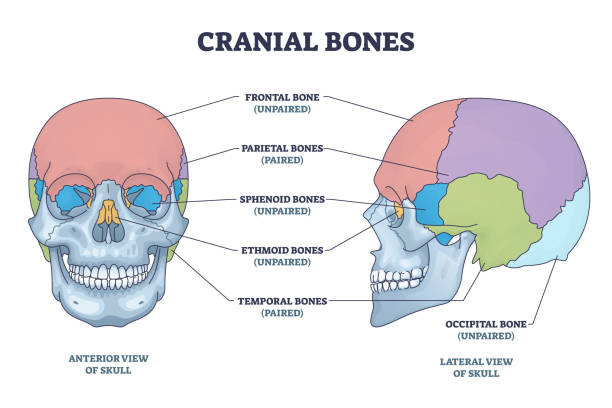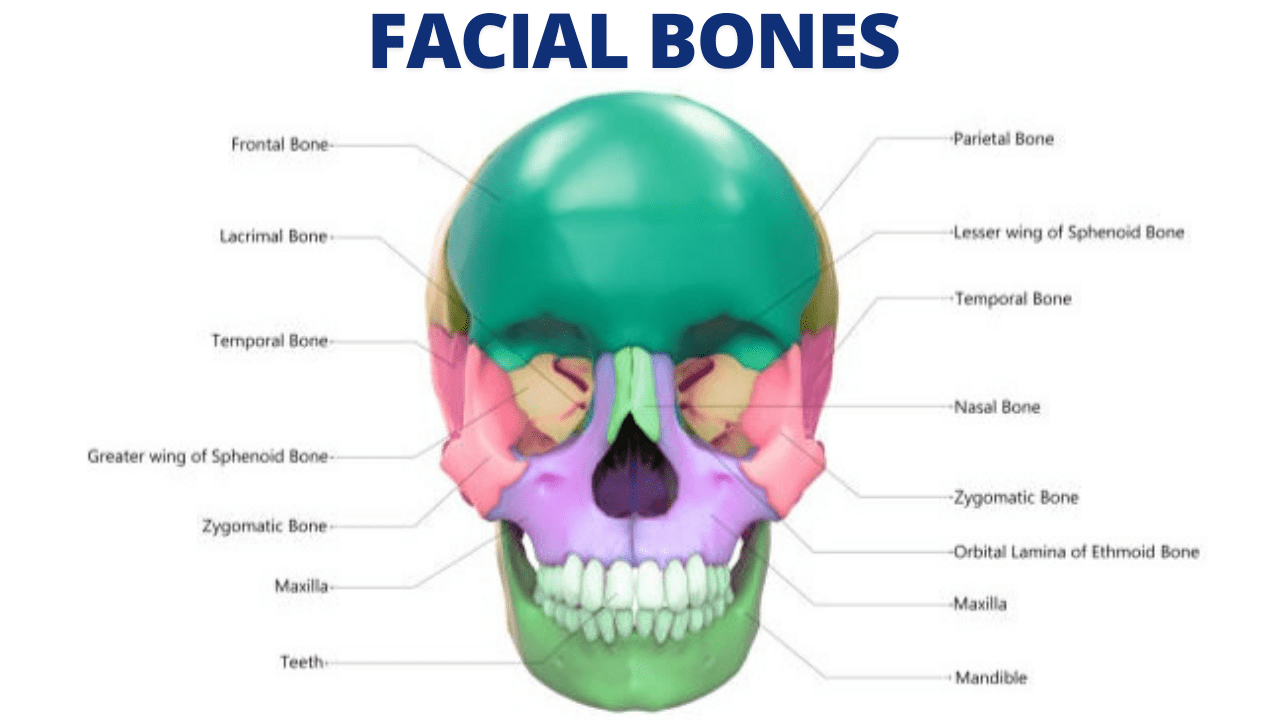Facial Anatomy & Face Shapes
Sakshi Verma | 9 Nov,2024

In this notes
Introduction
In order to make us look more attractive, makeup is applied to our faces to highlight and improve their features. The underlying bone and muscle anatomy determine the shape of our faces.
To produce the necessary makeup and look, a makeup artist must have understanding of facial anatomy and shapes.
Makeup, skincare, and even hairstyles depend quite much on facial anatomy and shapes. Understanding how your facial structure is built will help you with informed decisions in enhancing your natural beauty. Let's take a closer look at an easy-to follow guide to understanding facial anatomy and the different face shapes, including tips for identifying your face shape and embracing it.
Bones of Face

• The skeleton of the head is the skull, which is made up of 22 bones. The face and the skull are its two distinct portions.
• The skull forms the base of your facial features.
• It consists of the cranial bones (forehead and upper head) and facial bones (cheekbones, jawline, and eye sockets).
• Our bone structure defines the features of our face.
Cranium Bones (8 bones)

Image credit to : iStocks
• The cranium, which is composed of eight bones, is the posterior portion, or back of the head.
Occipital (1 bone)
• The lower back of the skull is formed by a single occipital bone.
Parietal (2 bones)
• There are two parietal bones. Shapes the head's crown and sides.
Frontal (1 bone)
• There is only one frontal bone. Shapes the forehead.
Temporal (2 bones)
• There are two temporal bones. Forms the head's sides in the area around the ears.
Ethmoid (1 bone)
• The ethmoid bone is only one which Forms a portion of the nasal cavity between the eye sockets.
Sphenoid (1 bone)
• One sphenoid bone connects all of the bones in the cranium.
Face Bones (14 bones)

Image credit to : iStocks
• The 14 bones that make up the face are the anterior or front portion of the head.
Nasal (2 bones)
• The bridge of the nose is made up of these two bones.
Lacrimal (2 bones)
• There are two bones, which are found in the inner portion of the eye socket's walls.
Zygomatic or Malar (2 bones)
• There are two bones which present in cheek bones.
Maxillae (2 bones)
• There are two bones which present in the upper jawbones.
Mandible (1 bone)
• The largest and strongest bone in face is the lower jawbone (mandible).
Turbinal (2 bones)
• There are two bones on the nasal depression's outer walls.
Vomer (1 bone)
• The nose's separating wall is made up of vomer bone.
Palatine (2 bones)
• The two bones comprise the hard palate along with the maxillae.
Skin Layers
Epidermis
• The outermost layer, which provides protection.
Dermis
• This layer contains collagen and elastin, responsible for skin firmness.
Subcutaneous layer
• It is fat cushion that provides a bulk and contours to the face.
Face Shapes
All of the features must be balanced for the makeup to be flawless. No feature exists in a vacuum, therefore balancing any one aspect of the face affects the face overall. It is possible to generate the appearance of an ideal face by using face shapes as a guide.
Understanding Face Shapes
When it comes to getting the ideal makeup, face shape is the most crucial factor.
The following are the measurements you will take:
(i) Measure how far apart your cheekbones are on your face. The measurement should be noted on paper.
(ii) Take a measurement from the widest point to the broadest point on your jaw line. Note the measurement.
(iii) Take a measurement at the broadest point across the forehead. The broadest point is often located approximately midway between your hairline and eyebrows. Write down the measurement.
(iv) Measure from the tip of your hairline to the base of your chin.
Type of Face Shapes

Image credit to : iStocks
1. Oval
• Length with a softly rounded hairline, one and a half times the width, and a little thinner at the jaw line than at the temples.
• The face is slightly longer than it is wide.
• Forehead is slightly wider than the jawline.
• The jaw is rounded with no harsh edges.
• The widest point is the cheeks.
• The face looks like an upside-down egg.
Note
Ideal/ perfect face shape is oval.
2. Round
• The forehead and jaw line of your face are more rounded. The face is free of sharp edges. The broadest areas are the ears and cheeks.
• Its forehead and jawline measures nearly the same width.
• The forehead is curved.
• The jawline is full and rounded, no angles or points.
• The widest point is the cheeks.
3. Oblong
• The face is longer than wide and has a narrow width.
• Long and narrow, approximately the same width across forehead and just below cheekbones. Possibly very long or very high forehead.
• Face is longer than it is wide.
• The width of the face is small.
• The jawline is softly curved and possibly pointed.
• Forehead is curved.
• The forehead and jawline are equal in width.
• Face is straight along the sides.
4. Triangular
• Narrow in the forehead, broad at the jaw line. Reverse of the heart shape.
• The forehead is narrower than the jawline.
• Jawline is the widest part of the face.
• Frequently, the jawline is sturdy and well-defined.
• The cheekbones are not as projected compared to the jawline and are tapering towards the forehead.
• The face is longer than it is wide, although individuals vary slightly in this regard.
5. Heart
• Narrow at the jaw line, wide at the forehead and/or cheekbones.
• Face is wide at the temples and hairline.
• Narrow down to be small, delicate chin.
• The face is longer than width.
• The forehead is the broadest part of a face.
• The sides of the cheeks taper into the jaw.
• The chin is narrow and pointed.
6. Square
• Your face is usually the same width as it is long, and your hairline is often square.
• The length and width of the face is the same size.
• The sides of the face straight.
• The jaw is board and visibly square shaped.
• The chin is typically broad, not pointed.
• The widest point is on the cheeks.
7. Diamond
• Narrow forehead and jaw line with almost similar widths, widest at cheekbones.
• A cross between heart and a dramatic oval. Widest at the cheekbones, and narrow equally at the forehead and jaw line.
• The face is longer than it is wide.
• The forehead and jawline are the same width.
• The jaw line is long and tapers to a pointed chin.
• The cheeks are the widest portion.
• The cheeks are quite high.
How to Determine our Face Shape
You can easily determine your face shape. Just follow these simple steps:
1. Tie Back Your Hair
• Tie your hair back to reveal your facial outline.
2. Study Your Dimensions
• Take a straight-on photo or look into a mirror.
• Pay attention to the width and length of your forehead, cheekbones, jawline, and chin.
3. Measure Your Face
Using a measuring tape, record these measurements:
Forehead Width
• Measure from the widest points across the forehead.
Cheekbone Width
• Measure from one cheekbone to the other.
Jawline Width
• Measure from one corner of the jaw to the other.
Face Length
• Measure from the top of your forehead to the bottom of your chin.
4. Compare Ratios
• Determine which features are widest or longest to match your measurements with the face shapes mentioned.
Summary
Finally, in order to achieve balance and enhance natural attributes through the placement of make up products, it is very important in make up artistry to know the facial anatomy and the different shapes of faces.
Makeup artists utilize techniques that accentuate the individual’s facial characteristics and flattering them as well as creating a balance and enhancement to the overall look, because they understand the different contours, proportions and structure of every face shape.
This basic training on anatomy enhances skills besides enabling make up artists to appreciate every face and design a different approach for it.
Understanding your facial anatomy and face shape can give you a different approach in beauty, whether it be skincare, makeup, or hairstyles. Accentuate these features rather than trying to hide them. You just have to find the right fit for your face shape, and then let your best features shine.
FAQs
1. What is facial anatomy, and why does it matter?
Facial anatomy refers to the structure of your face, including bones, muscles, fat pads, and skin layers. Knowing how your face is structured helps in choosing the right makeup, skincare, and hairstyles that complement your features.
2. How can we determine our face shape?
To identify your face shape:
(i) Pull your hair back and observe your face in a mirror or take a front-facing photo.
(ii) Measure your forehead, cheekbones, jawline, and the length of your face.
(iii) Compare the proportions to the characteristics of common face shapes, such as round, square, oval, or heart-shaped.
3. Does face shape change over time?
Yes, your face shape may change through age or weight changes. Over time, factors that include fat loss, alterations in bone density, and decreased elasticity in the skin can all alter the contour of facial features.
4. Is one face more attractive than another?
Beauty is subjective, and all face shapes have their own charm. Oval faces are considered balanced, while heart and diamond shapes are admired for their cheekbones. What matters most is enhancing your natural features and feeling confident in your look.
5. Is there more than one type of face shape?
Many individuals will overlap in various face shapes with a combination of features. So, for example, you might have a heart-shaped forehead, and your jawline could be rounded. You can take the best styling or makeup techniques that would complement each of your unique features.